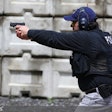In "Visualization Doesn't Work for All Officers," we began a discussion on the different ways people process information and the difference between the words we imagine and visualize as it relates to imagery.
We ended that post with the following question:
If you are one of those people (as I am), the question is how can you overcome this apparent hurdle to ensure that you can harness the power of your subconscious?
The answer is simple; it lies in a competing theory on how the mind processes information; the theory that the mind processes and stores information in images, not in pictures. Each person experiences those images in a way that is unique to them.
For some of us, imagery is more of an awareness, a feeling or an experience involving multiples senses with no pictures. This is every bit as powerful a tool for programming the subconscious mind, as for those who see pictures.
Some people imagine events in the first person, as if they are actually living it, while others experience events in the third person. For visual people, the images will be in pictures although they will experience the images differently.
Variations include the clarity of the pictures and whether they appear in black-and-white or color. Even here, there are varying degrees of the brightness or vividness of colors. Some people experience imagery sporadically, switching between pictures and an experience with no pictures.
People always ask me, "Is it normal to experience (fill in the blank) when I'm doing imagery?" The answer is always, yes. If you experienced it, then it's normal for you. Every person will experience imagery in his or her own way.
The key here is to accept that everyone can imagine — not everyone can visualize. Some would argue that this is simply semantics and the two terms, imagine and visualize, mean the same thing and are therefore interchangeable. While it may mean the same thing to some people, it does not mean the same thing to everyone.
It's important to understand that the subconscious mind processes information literally. Therefore, visual language may only speak to those who process images in pictures.
For the rest of the population, you may as well be speaking a foreign language. This concept can be difficult for visual people to understand, but makes perfect sense to those of us who aren't visually wired. To those people who have read sports psychology books and sat through visualization sessions wondering what was wrong with them — why don't they see the pictures — this theory makes perfect sense.
If you are one of the non-visual people, please understand that you can imagine — you can use imagery to help program the subconscious mind. Every time you hear the word visualize, think imagine. When you hear someone tell you to picture something in your mind, or see it in your mind's eye, simply allow yourself to imagine it. You might be surprised at how powerful this simple shift in thinking becomes for you.
If you're a trainer, please replace the word visualize with imagery in your training sessions. You will be doing a great service to all of your officers.
Editor's Note: Brian Willis is the deputy executive director of the International Law Enforcement Educators and Trainers Association (ILEETA). Contact him via his website Winning Mind Training.

















